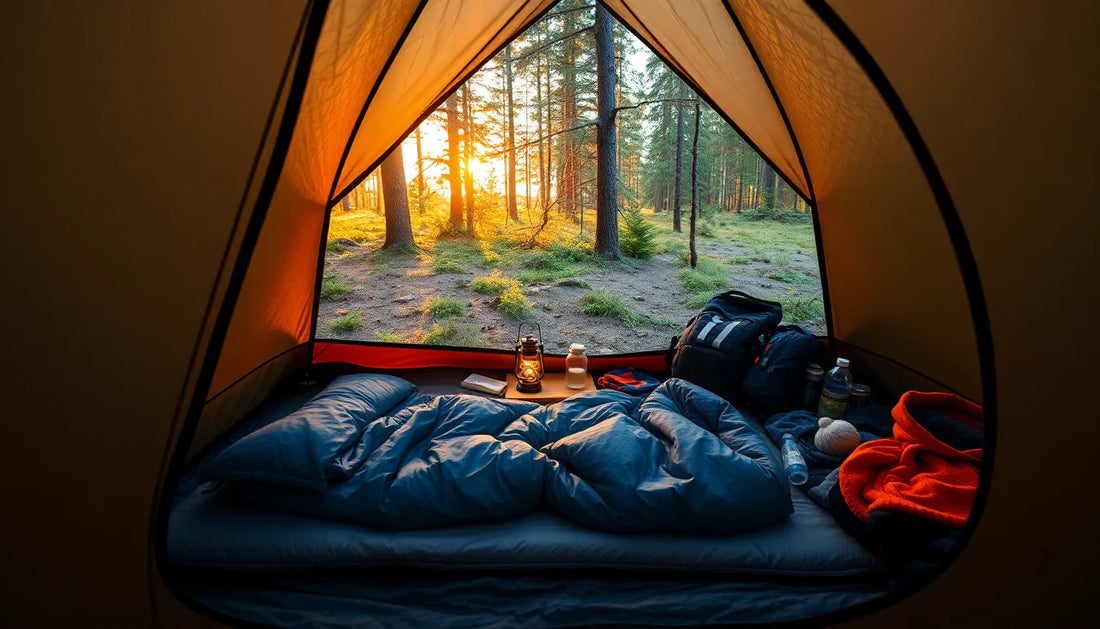
How to Stay Comfortable While Tent Camping: Tips for Better Sleep
Share
Camping under the stars can be a truly magical experience, but for many, the prospect of sleeping in a tent can be daunting. After all, the great outdoors presents a unique set of challenges when it comes to getting a good night's rest. From temperature fluctuations to uneven ground and noisy environments, there are several factors that can impact your comfort and sleep quality while tent camping.
However, with the right preparation and a few clever tricks, you can ensure a restful and rejuvenating camping experience. In this blog post, we'll explore a range of strategies and tips to help you stay comfortable and get better sleep while tent camping.
Choosing the Right Sleeping Gear
One of the most crucial elements of comfortable tent camping is the sleeping gear you choose. The right sleeping pad or mattress, coupled with a high-quality sleeping bag, can make all the difference in how well you sleep.
Selecting an Appropriate Sleeping Pad or Mattress
The surface you sleep on can have a significant impact on your comfort. Opt for a sleeping pad or mattress that provides adequate cushioning and insulation from the ground. Look for features like self-inflating technology, high R-values (a measure of insulation), and comfortable, durable materials.
Importance of a Quality Sleeping Bag
Your sleeping bag is another essential piece of gear that can make or break your camping comfort. Choose a bag with a temperature rating appropriate for the conditions you'll be camping in. Ensure it's made of breathable, moisture-wicking fabrics to keep you comfortable throughout the night.
Pillow Options for Tent Camping
While a pillow may seem like a luxury, it can significantly improve your sleep quality. Consider bringing a compact, inflatable camping pillow or using a stuff sack filled with extra clothing to create a comfortable headrest.
Temperature Control Strategies
Maintaining a comfortable temperature in your tent is crucial for a good night's sleep. Fluctuating temperatures, both hot and cold, can disrupt your sleep and leave you feeling restless.
Layering Clothing Techniques
Dressing in layers is key to regulating your body temperature. Wear moisture-wicking base layers, insulating mid-layers, and a warm outer layer to adapt to changing conditions throughout the night.
Insulation Tips for Tent and Sleeping Area
Ensure your tent is well-insulated to retain heat and block out cold drafts. Use a ground tarp or footprint under your tent to create a barrier between you and the cold ground. You can also use a reflective sleeping pad or insulating pad to further enhance the warmth of your sleeping area.
Choosing Appropriate Sleeping Bag Rating
Select a sleeping bag with a temperature rating that matches the expected conditions. If you'll be camping in colder weather, opt for a bag with a lower temperature rating to keep you warm throughout the night.
Creating a Comfortable Tent Setup
The way you set up your tent can also have a significant impact on your comfort and sleep quality.
Tent Site Selection
Choose a level, well-drained campsite that is protected from the wind. Avoid setting up your tent in low-lying areas or near water sources, as these can be prone to dampness and colder temperatures.
Ground Preparation
Carefully clear the area where you'll be placing your tent, removing any rocks, sticks, or other debris that could cause discomfort. You can also use a ground tarp or footprint to create a smooth, even surface.
Minimizing Noise and Light Disruptions
Noise and light can be significant sleep disruptors in a tent. Position your tent away from high-traffic areas and use earplugs or a white noise machine to block out external sounds. Consider using a sleep mask or hanging a dark, opaque material over the tent's windows to block out unwanted light.
Additional Comfort Hacks
Beyond the essentials, there are several additional tips and tricks you can use to enhance your comfort and sleep quality while tent camping.
Clothing and Moisture Management
Wear breathable, moisture-wicking fabrics to help regulate your body temperature and prevent the buildup of sweat, which can lead to chills. Bring extra layers and change into dry clothes before bed to ensure you stay comfortable throughout the night.
Sleeping Position Optimization
Experiment with different sleeping positions to find the most comfortable one for you. Side-sleeping, back-sleeping, or even a semi-fetal position can all be viable options, depending on your personal preferences and the specific conditions of your campsite.
Portable Comfort Accessories
Consider bringing along portable comfort accessories like a camping chair, a small table, or a headlamp to create a more inviting and functional sleeping area within your tent.
Conclusion
Achieving a good night's sleep while tent camping may require a bit of planning and preparation, but the rewards are well worth it. By investing in the right gear, implementing temperature control strategies, and creating a comfortable tent setup, you can ensure a restful and rejuvenating outdoor experience.
Remember, the key to comfortable tent camping is to anticipate and address the unique challenges that come with sleeping in the great outdoors. With these tips and tricks, you'll be well on your way to enjoying better sleep and making the most of your next camping adventure.
